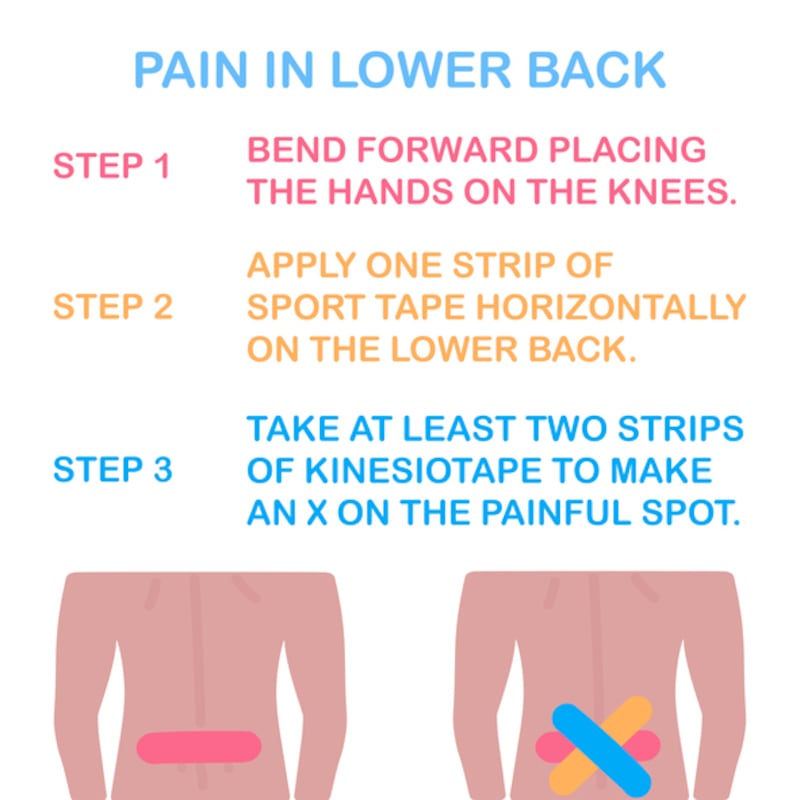Over the past decade there has been a global spread of a dinky, brightly-coloured product, strips of which are often seen adhering to the skin of runners, footballers and others.
Kinesio Tape first caught the public's attention at the 2008 Beijing Olympic Games when 50,000 rolls were donated to athletes, many of whom readily applied it, apparently convinced – or hopeful – that thus festooned, some benefit might be conferred on their affected body part(s).
The Run Ireland website states: "Kinesiology tape has been used to successfully treat sports people since the 1970s", but whether the treatment's success can be ascribed to the tape or a placebo effect is debatable. However, it's agreed that Kinesio Tape is a latex-free, water-resistant, hypoallergenic cotton fibre strip with a medical-grade acrylic adhesive which was developed in the 1970s by Japanese chiropractor Dr Kenzo Kase.

The tape, according to his website, "alleviates discomfort and facilitates lymphatic drainage by microscopically lifting the skin. This lifting affect forms convolutions in the skin, thus increasing interstitial space and allowing for a decrease in inflammation, reducing pressure while enabling a more effective flow of blood and lymphatic fluid in and out of the target area."
The extent to which scientific evidence supports this claim can be inferred from a 2012 piece in the International Business Times where Howard Koplowitz cites an article which "noted that the Japanese inventor who created Kinesio Tape, Kenzo Kase, admitted there was 'no scientific evidence' to support his claims".
More scientifically rigorous than an online quote is a recent review, undertaken by associate professor Dr Jennifer C Reneker of the University of Mississippi Medical Center, who analysed 15 published studies. Writing in the journal Physical Therapy in Sport, Reneker and colleagues considered the Effectiveness of kinesiology tape on sports performance abilities in athletes: A systematic review.
They concluded: “There is a lack of compelling evidence to support the use of kinesiology tape to enhance the sports performance abilities based on this review.”
As Reneker and colleagues note, since the advent of Kinesio Tape, “there have been many similarly developed dynamic elastic adhesive tapes, collectively known as kinesiology tape”.
Internet claims
It is probable that many people who buy kinesiology tape (KT) do so after reading about the product online. How reliable are internet claims of KT’s effectiveness?
When orthopaedic surgeons Drs Bryan G Beutel and Dennis A Cardone analysed the content of 31 websites, they found 58 per cent of the sites used anecdotal testimonials to promote their products, and writing in the International Journal of Sports Physical Therapy, they concluded: "Websites discussing KT are predominantly of poor quality and present misleading, imbalanced information."
Might it be that KT works but that those who claim it doesn’t are using it incorrectly?
This possibility was raised during a dispute conducted in the pages of the Journal of Physiotherapy. In 2015, following a study by Guilherme Nunes and colleagues of 36 athletes who participated in seven different sports, their conclusion was succinctly expressed in the study's title: Kinesio Taping does not decrease swelling in acute, lateral ankle sprain of athletes: a randomised trial.
This provoked a stern rebuke from Kim Stockheimer and colleagues of Kinesio Taping Association International who told the journal that: "This study does not meet the lowest standard of responsible scientific research." They complained that Nunes' team didn't "include anyone certified or extensively trained in the Kinesio Taping Method".
Stockheimer and colleagues further explained that “with Kinesio Taping the pressure decreases due to lifting of the superficial skin, and blood and lymphatic circulation increase due to an increase in subcutaneous space.” To which Nunes and colleagues responded: “We really would like to have a reference to a published study demonstrating that this in fact occurs; however, we are yet to find such a study.”
This brings to mind an observation of the late Christopher Hitchens, albeit in relation to religion, but perhaps applicable to KT: "What can be asserted without proof can be dismissed without proof."

Potentially beneficial role
Yet there is no denying that the results of some studies point to a potentially beneficial role for KT, perhaps as an adjunct to the treatment of some conditions. For example, writing in the journal Archives of Gynecology and Obstetrics (2016), Turkish researchers described the Effects of exercise and Kinesio taping on abdominal recovery in women with Caesarean section: a pilot randomized controlled trial. Their study of 24 women found that, compared to exercise alone, "[I]t appears that the addition of KT to abdominal exercises in the postnatal physiotherapy programme provides greater benefit for the abdominal recovery in women with caesarean section."
Similarly, a 2016 study entitled Kinesio taping for chronic low back pain: A systematic review – published in the Journal of Bodywork & Movement Therapies (2016) – concluded that although KT is not a replacement for traditional physiotherapy or exercise, "[R]ather, KT may be most effective when used as an adjunctive therapy, perhaps by improving range of motion, muscular endurance and motor control."
It appears the evidence for the benefits claimed by those who endorse KT as an effective treatment for musculoskeletal problems is open to challenge. However, it might be that KT could serve as a useful means of augmenting other proven therapies.
Clearly, further research is needed.










